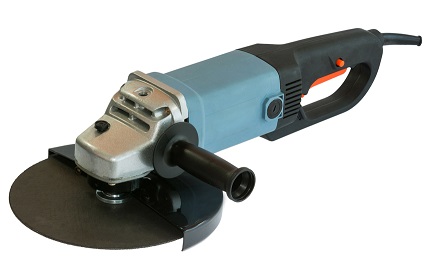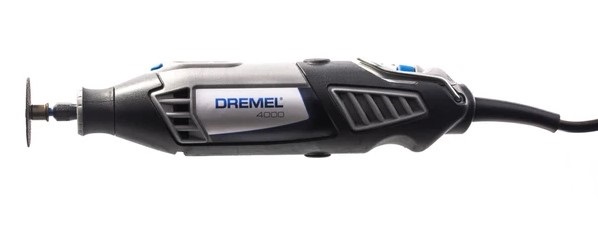Dremels and angle grinders are multipurpose power equipment extensively employed in the metalworking and woodworking sectors. Nevertheless, these two instruments’ strength, size, and intended application may vary. An angle grinder is an effective tool that uses a disc or wheel to grind, cut, or polish stone or metal.
However, a Dremel is a small, portable rotary tool frequently used for exemplary operations like engraving, cutting, and sanding. So, let’s go through the article, where we will examine the distinctions between angle grinders and Dremels to clarify which device is ideal for your particular requirements.
Outline
ToggleWhat is an Angle Grinder? 
Using a disc or wheel, an angle grinder is a powerful instrument used by commercial contractors, often to cut, grind, or polish different materials, including metal, stone, or concrete. The operator may quickly grind or cut through materials via the grinder’s disc attached to a spindle that spins rapidly.
Angle grinders come in various sizes, from compact portable devices to large, industrial-sized equipment. Also, angle grinder discs typically come in 4.5- and 7-inch sizes. They are multipurpose equipment you may use for various jobs, such as cutting metal, cleaning paint or rust, sculpting and sharpening items, and polishing surfaces.
Contractors frequently employ them in DIY, building, and metalworking tasks. Various kinds of angle grinders are accessible in the market. Each features unique characteristics and requirements. Angle grinders come in various popular designs, such as:
- Angle grinder with power cord: This model is perfect for demanding tasks requiring a steady power source and a power cord.
- Pneumatic angle grinders: Angle grinders that use compressed air as their power source are called pneumatic grinders or air grinders. They’re perfect for demanding jobs requiring a lot of power output.
- Angle grinders without cords: Operated by rechargeable batteries, cordless angle grinders provide greater flexibility and mobility than tethered ones. They function best when given light to medium-duty jobs.
- Mini Angle Grinder: These angle grinders are available in smaller sizes and are helpful for precise tasks like cutting tiles, honing blades, and buffing tiny areas, as their name implies.
- Angle grinder with variable speed: This model permits the user to control the grinding wheel speed, making it perfect for cutting precisely and dealing with various materials.
Safety is essential when operating an angle grinder because the rotating disc’s rapid speed might result in significant harm when not handled properly. Putting on the appropriate safety gear, such as gloves, a face shield, and safety glasses, is crucial. To guarantee the secure functioning of the instrument, operators must also adhere to the manufacturer’s usage and maintenance guidelines.
What is a Dremel?
A mobile rotary tool known as a Dremel is frequently employed for various operations, including sanding, carving, engraving, cutting, and polishing. It’s a flexible tool to apply to various surfaces, such as ceramics, metal, wood, and plastic. Dremels are perfect for fine work and small DIY projects because they are small and lightweight. They include various accessories and extras, such as polishing pads, cutting wheels, sanding discs, and grinding stones. Users may swiftly transition between jobs because of the attachments’ simple interchangeability.
The adaptability of a Dremel is among its most incredible benefits. You may employ it for many things, including carving, engraving, grinding, and sanding. Additionally, it is a well-liked option for hobbyists, painters, and jewelry producers needing precise work.
Dremel offers a selection of rotaries to accommodate stringent customer requirements and preferences. Below you’ll go through a few of the most prevalent Dremel rotary tool categories:
- Corded Rotary tools: Traditional rotary tools made by Dremel that operate with a power cord are known as corded rotary tools. They’re perfect for heavy-duty applications since they deliver reliable power.
- Cordless rotary tools: The best tools for light- to medium-duty work are cordless, battery-powered models because they offer more movement and versatility.
- Multi-tools: Multi-tools are rotary tools with several accessories and attachments that enable people to complete various tasks with just one tool. You may utilize them for various purposes, and they are versatile.
- Highly efficient rotary tools: These implements are more powerful, rigid, and equipped to handle complex tasks. Due to their higher velocity and torque, they’re excellent for challenging tasks.
- EZ Twist nose cap: The “twist nose cap” feature of these Dremel rotary tools makes it possible to swap out accessories quickly and easily without needing a wrench.
Security is a crucial consideration while using a Dremel. Operators need to wear protective clothing, including goggles and gloves, and follow the usage and maintenance instructions provided by the manufacturer.
Difference Between Angle Grinder and Dremel
Below is a comparison table between the Angle grinder and the Dremel, so let’s glance at it:
| Basis | Angle Grinder | Dremel |
| Layout | Angle grinders feature a bulky structure, often with a two-handle design that improves control and stability. | Dremels are designed to be smaller, lighter, and more compact featuring a single handle, and possess a pen-like chassis with various replaceable pieces. |
| Working Theory | They function by rapidly spinning the disc or wheel, resulting in friction and wearing away the substance. | Dremels make use of a rotary tool that spins quickly. |
| Type of cutting blade | Angle grinders frequently employ gritty cutting blades or discs of silicon carbide, diamond, or aluminum oxide. | Dremels feature tiny and thin cutting blades better suited for sensitive jobs, including cutting into thin sheets of metal or plastic. |
| Size and weight | Typically weigh between five and ten pounds and are twelve and sixteen inches long, making them heavier than Dremels. | Dremels are more portable and lightweight.
Weighs between one and two pounds and ranges from six to nine inches. |
| Uses | Ideally cuts, grounds, and polishes concrete, metal, or stone.
Perfect for building and remodeling jobs as well as auto repairs. |
Ideal for precision work like engraving, sanding, and cutting delicate materials such as wood, plastic, and ceramics.
Used for polishing, cleaning, and buffing. |
| Power source | Contractors use electricity or air compressors to power angle grinders. | Dremels are frequently electrically powered tools with a cord or operate cordlessly on rechargeable batteries. |
| Depth of cut | Due to the broader and thicker cutting blades, angle grinders may cut deeper than Dremels. | Due to their smaller dimensions and narrower cutting blades, Dremels have less cut depth than angle grinders. |
| Price | Expensive as it can cost between $50 to more than $500, while Industrial-grade versions can cost over $1000. | Dremels range from $20 to $200, making them more inexpensive than angle grinders. |
| Safety | Angle grinders are harmful, so use them only with attention and wear heavy-duty gloves and protective glasses while working. | Dremels are typically safer than angle grinders, yet you must wear protective glasses and a respirator. |
| Versatility | They are versatile for various jobs since they may be utilized with various blade types and accessories. | Dremels are multipurpose tools and can be used with various accessories. |
| Accessories | It can be used with various attachments, such as wire brushes, polishing cushions, cutting edges, grinding wheels, and sanding discs. | Dremels arrive with various attachments, such as sanding drums, grinding rocks, cutting wheels, and finishing pads. |
| Finishing | You may utilize Angle grinders for finishing activities like grinding and sanding, and they perform well for coarse finishing tasks. | Because of their more diminutive stature and incredible speed, Dremels can produce fine details with great accuracy. |
| Lubrication | Requires lubrication, while certain angle grinders include an automated motor lubrication system incorporated into the machine. | Possess a sealed motor, so you don’t need to lubricate them. |
Angle Grinder or Dremel- Which one Should You Buy and Why?
The work determines whether to use a Dremel or an angle grinder. Both instruments have advantages and disadvantages, so you must choose efficiency and safety to select the proper one for the job.
Below are a few points to consider when choosing between a Dremel and an angle grinder.
1. The Current Task
The work at hand should be considered before deciding between an angle grinder and a Dremel. Angle grinders are potent devices for cutting, grinding, and shaping hard materials like concrete, metal, and various kinds of stone. The elimination of rust or the smoothing of welds are examples of massive undertakings that benefit significantly from their use.
Dremels are less heavy and more portable, making them perfect for modest DIY jobs and precise operations. They’re perfect for engraving, carving, and sanding that require agility and precision.
2. Speed and Strength
You must likewise consider the tool’s speed and power while deciding whether to pick an angle grinder or a Dremel. Angle grinders are perfect for heavy-duty applications because they are frequently more powerful and have faster speeds.
The immense speed and strength they possess, though, may render them more hazardous and difficult to master. On the other hand, angle grinders are less potent than Dremels but provide greater oversight and precision.
3. Concerns for Safety
Dremels and angle grinders can be hazardous when you don’t use them properly. Angle grinders may prove dangerous when the user has lost grip or in case the blade breaks, whereas Dremels can result in burns, wounds, and eye injuries when the operator fails to exercise caution.
Wearing safety equipment, such as eye protection, gloves, and a mask, is crucial while employing either tool. Additionally important is adhering to the maintenance and use guidelines provided by the manufacturer.
4. Accessibility and Portability
Other essential factors to consider when deciding between an angle grinder and a Dremel are convenient operation and portability. Angle grinders might be more challenging to move because they are frequently more extensive and heavier.
Dremels, on the other hand, are smaller and lighter, which makes them simpler to operate in confined spaces and transport from one place to another.
5. Cost
Whether you choose an angle grinder or a Dremel based on price, in the end, depends on your budget and desired application. A cheap Dremel model can be your best bet if you need a tool for precise work and are on a tight budget. Nevertheless, spending more money on a more expensive angle grinder can be worthwhile if you need a powerful instrument for building or remodeling work.
When choosing a tool, it’s crucial to consider its durability and long-term value. A more expensive tool may wind up sparing you money in the long term by surviving longer and needing less maintenance or adjustments.
Conclusion
Angle grinders and Dremels each have their benefits and drawbacks in general. You must comprehend the distinctions between the two and consider your needs before investing.
Angle grinders work well for demanding tasks, while Dremels are more precise and versatile. You can choose the tool that best fulfils your demands by considering design, cutting edges, dimensions, energy source, security, and pricing.



